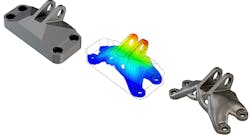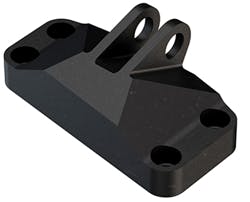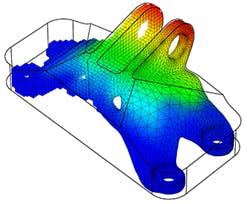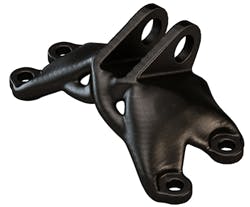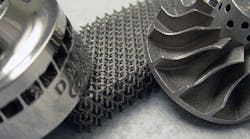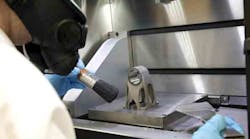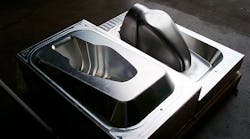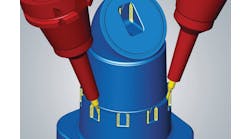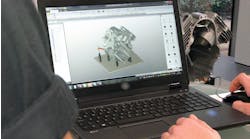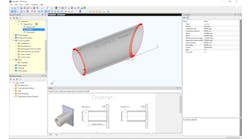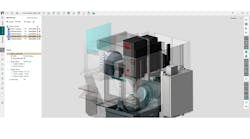For hundreds of years manufacturers have compromised original design concepts to achieve “manufacturability.” Even accounting for progress in design, materials, and production processes, conventional manufacturing techniques have limited the ability to realize complex geometries or organically shaped components in a cost effective way. Thus, the finished components represent a “trade-off” in functionality and performance.
Now there is 3D printing. Particularly in industrial operations, Direct Metal Printing (DMP) has become a viable manufacturing alternative, and many of the constraints imposed by traditional manufacturing have been removed. This has prompted new developments in software functions for Multi-Disciplinary Design Optimization, products that now are putting design and manufacturing at a new convergence point: Topology optimization software is capable of generating the most efficient designs for one-step manufacturing on the latest generation of DMP systems.
In short, what you model is what you manufacture.
This confluence of technologies was demonstrated recently in a project undertaken by software developer Frustum and 3D Systems' on-demand parts service, Quickparts. The project was a publicized challenge by GE Aviation to reduce the weight of an aircraft bracket while maintaining the strength needed to meet all of its functional requirements, primarily to support the weight of the cowling while the engine is in service
The critical nature of weight — Since the beginning of motorized travel (land, sea, or air), engineers have strived to balance the demands of vehicle weight versus strength. The balancing act has become more critical in recent years with greater global competition among manufacturers, stricter energy conservation measures, escalating cost, and delivery time pressures.
Weight is especially crucial for modern aircraft. Although a Boeing 737 weighs approximately 65 metric tons, eliminating only one pound of weight can promote savings of hundreds of thousands of dollars annually for airlines. Spread that number out to include all aircraft worldwide and the savings are upward of $10 million, according to a GE Aviation white paper.
Optimizing the design — For the GE Aviation challenge, Frustum's software for topology optimization provided the first steps in tackling critical weight-vs.-strength issues. Topology optimization determines the most-efficient material layout to meet the exact performance requirements of a part. It takes into consideration the given space allowed, load conditions of the part, and maximum stresses allowed in the material.
Frustum's software automatically generated optimized geometries from existing CAD files. It created material between the design features to make the final structures optimally stiff and lightweight. Smooth and blended surfaces reduce weight and minimize stress concentrations.
"Based on an existing conventional part design, our software automatically produces optimized geometry for additive manufacturing, without needing to do any remodeling," CEO Jesse Blankenship said.
Unlike parts manufactured by metalcasting or CNC machining, the complexity of the model generated by topology optimization presents no manufacturability concerns, as DMP handles extremely complex models as easily as simplistic ones. Complexity comes at no cost.
3D printing expertise — Once the initial design was generated, 3D Systems' expertise came into play. Quickparts, the On-demand parts manufacturing service, supplies customers with custom-designed parts, offering instant online quoting, expertise in 3D design and printing, and manufacturing services support. It’s a global service with broad experience in the more complicated aspects of DMP.
"Direct Metal Printing is much more complex than plastics printing," said Jonathan Cornelus, business development manager for 3D Systems Quickparts. "We help our customers to develop parts suitable for DMP, with minimized risks for part distortions or build crashes. We print components using optimized parameters based on our long-term experience in printing parts for customers."
Manufacturing a better part — In the case of the GE aircraft bracket, Frustum's software took the original CAD file and performed the topology optimization in one step, delivering an STL file.
3D Systems provided manufacturing advice on the process, material specifications, the best build orientation to deliver optimal part properties, achievable tolerances, and identified potential risk for deformations.
The part was built on a 3D Systems ProX™ DMP 320 system, a model introduced in early January that offered several advantages for optimizing weight-versus-strength for the aircraft bracket.
Preset build parameters, developed by 3D Systems based on the outcome of nearly half-a-million builds, provide predictable and repeatable print quality for almost any geometry. A new product architecture simplifies project set-up, and the system is versatile enough to produce all types of geometries in titanium, stainless steel, or nickel super alloy. Titanium was chosen for the GE aircraft bracket, based on its superior strength even when material is thinly applied to lower a part's weight.
Exchangeable manufacturing modules for the ProX DMP 320 system reduce downtime when moving among different part materials, and a controlled vacuum build chamber ensures that every part is printed with proven material properties, density and chemical purity. The small portion of non-printed material can be completely recycled, saving money and providing environmental benefits.
Opening eyes — The completed part, designed by Frustum and DMP-manufactured by 3D Systems, passed all the load condition requirements specified by the GE challenge and stayed within the same footprint while reducing weight by a staggering 70%.
"This is the kind of project that should be a real eye-opener for automotive and aerospace companies, where reducing weight while providing the same or improved functionality is the lifeblood of their design, engineering and manufacturing operations," according to Cornelus.
Beyond the design and performance of the part itself, Cornelus pointed out that topology optimization teamed with DMP can consolidate multi-part assemblies into a stronger, unitary part, eliminating fasteners and connectors that may be the cause of structural failure.
Finally, there is the coveted advantage of development time: Production-grade parts in tough materials such as stainless steel, titanium, and nickel super alloy can be completed by 3D Systems in as little as two weeks, to satisfy the accelerating pace of progress.
